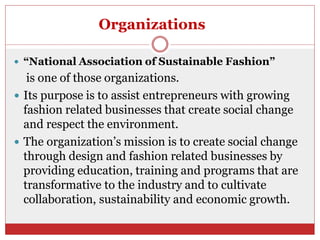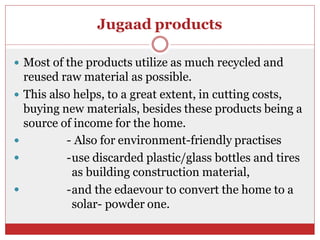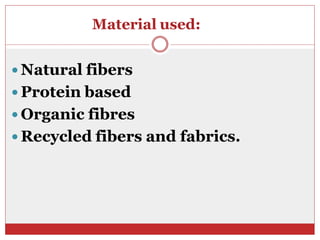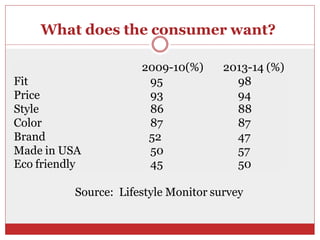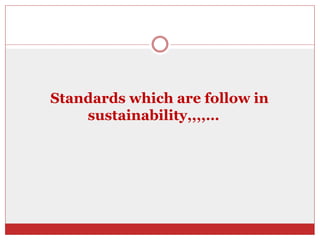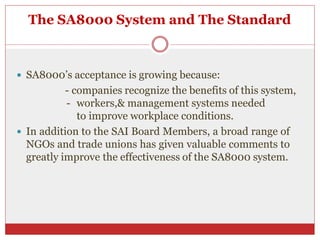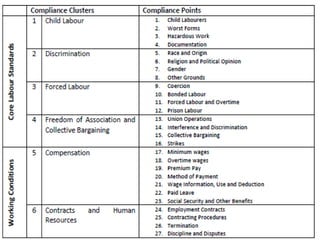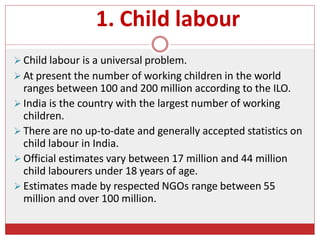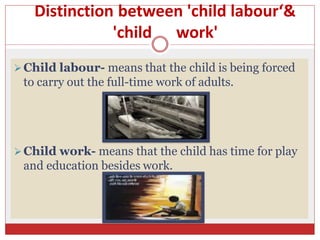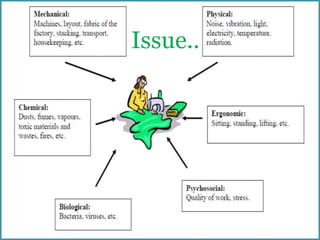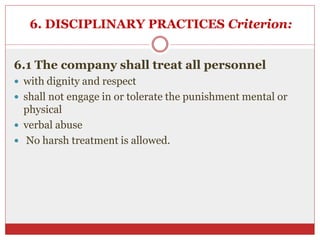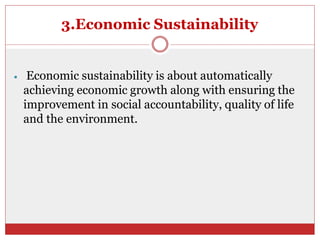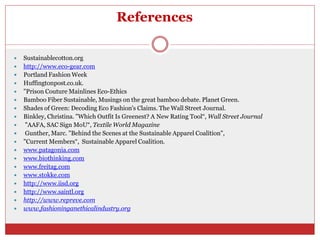Feroz mahmud 20381101 sustainable_ fashion
- 1. Sustainable Fashion.. Ameansfor social transformation Submitted by: Feroz Mahmud ID-20381101 Batch-13 (A) KIM-Intake-5 mahmud.brac13a@gmail.com
- 2. Whatissustainability To "Sustainable" means "to maintain" or "to support“. It interfaces with economics through the social & environment where social aspects including cultural, health-related and financial aspects are integrated. Moving towards sustainability is also a social challenge that entails international and national law, urban planning and transport, local and individual lifestyles and ethical consumers. The considerations relating to fashion includes: - environmental protection, - social justice, - economic fairness - cultural vitality.
- 3. Sustainable development “sustainable development” that meets the needs of the present, without compromising the ability of future generations.
- 4. Objective The sustainability objective are: - to promote the production (i.e. development of less polluting, more resource efficient products, processes and services) - consumption of environment friendly textiles - reduce poverty and improve the quality of life - for artisans in the textile and craft sectors.
- 6. Designers Stella McCartney Amour Vert Edun Stewart Brown Shalom Harlow Summer Rayne Oakes
- 7. Organizations “National Association of Sustainable Fashion” is one of those organizations. Its purpose is to assist entrepreneurs with growing fashion related businesses that create social change and respect the environment. The organization’s mission is to create social change through design and fashion related businesses by providing education, training and programs that are transformative to the industry and to cultivate collaboration, sustainability and economic growth.
- 8. Karm Marg Karm Marg is a non-governmental organization that runs a home The focus group for karm marg disadvantaged children and young adults to live, study, and play together in and also the economically backward rural women from villages. Eventually the products made by them are sold under the brand ‘jugaad’.
- 9. Jugaad products Most of the products utilize as much recycled and reused raw material as possible. This also helps, to a great extent, in cutting costs, buying new materials, besides these products being a source of income for the home. - Also for environment-friendly practises -use discarded plastic/glass bottles and tires as building construction material, -and the edaevour to convert the home to a solar- powder one.
- 10. Green the Gap: waste made wonderful ‘Green the Gap is all about Recycling: - Designing the product, - Choosing waste material to be used & sourcing of the raw material.
- 11. Tsunamika successful and fulfilling socially responsible communication design intervention for Upasana. Tsunamikas have never been bought or sold. They are shared, unconditionally; they are gifts of love and friendship. There are some other waste materials that conserve uses for its products.
- 12. Tsunamika Rubber tube: soft and durable material, the rubber obtained from old truct tyre inner tube, which would otherwise be wasted, Is an alternative to traditional bag materials like leather, Once it is washed, it is cut into required shape or pattern to make bags. Also transforming the worn out tyres into piece of furniture like high stools, centre tables, sofa sets, office chairs, clocks, mirrors and painting frames.
- 13. Conserve Denim: conserve offers its patrons to send their old pair of jeans that may have holes in the knees, but are otherwise fine, to be converted into bags. Seat belts: rolls of seat belt material lying un-used with manufacturers are woven together into material for bags.
- 14. Goonj Goonj collects old clothes and other needed materials from urban homes, and uses them as resources for poor. Today Goonj works across - 21 states - 250 partner groups. - 10 offices - 150 full time people - thousands of volunteers. Dealing with 100 tons of material each month. Goonj has an annual budget of 3-4 crore INR. declared ‘Indian NGO of the Year’, Also prestigious Development Market place award from the World Bank on making a sanitary napkin out of waste cloths.
- 15. People Tree People tree is a design, production and retail centre, which combines a sense of social purpose & ecological responsibility with the spirit of collective talent they posses in the skill of stitching and embroidery of cloth. Attractive path of work from small pieces of waste clothes, making different size quilts and sheets are excellent examples of their traditional art and crafts from Sindh and Multan. In this manner the women’s re able to earn along with performing their household tasks.
- 16. Thunk in India :Re Think Waste Thunk’s vision is to innovate with everyday waste materials, whether the materials are from household , industrial or natural waste.
- 17. Domestic market research for Eco-friendly & sustainable Textile product (AIACA) The All India Artisans and Craft workers Welfare Association (AIACA) - a not-for profit organization - working for the crafts sector in India. - the project seeks to promote sustainable production and consumption practices in the textile and craft sector in India. - to promote the production (i.e. development of less polluting and more resource efficient products, processes and services) - and consumption of environment-friendly textiles to reduce poverty - and improve the quality of life for artisans in the textile and craft sectors.
- 18. Sustainability Issues in Fashion Labour Water Waste CO2: CO2:
- 19. Impacts For example: 1 kg of cotton requires 11,000 litres of water. It takes 2,600 litres of fresh water for 1 cotton t-shirt. Textile waste is approximately 5% of landfill space worldwide. 15% of fabric intended for clothing ends up on the cutting room floor 10% of total global impact is associated with the global textile industry
- 20. 3 E’s of Sustainability A diagram indicating the relationship between the three pillars of sustainability
- 21. 3 E’s of Sustainability Environmental Sustainability– ability to maintain the valued qualities of the physical environment. It refers to preservation of the environment & natural resources. Social Sustainability- important aspect of sustainable development. It encompasses human rights, labor rights, and corporate governance. Economic Sustainability - This is about achieving economic growth along with ensuring the improvement in quality of life and the environment.
- 22. 1. Environmental Sustainability To manage wastes and recycle these: - especially water - reduce pollution For example: Electrical boiler replaced diesel boiler in Classic Jeans unit. Heavy oil replaced diesel in the laundry unit. 60% of fresh water replaced by recycled water.
- 23. Corporate Responsibility Organic clothing Recyling clothing Reducing Allergens Reducing Toxic Chemicals Organic Feels Good Sustainability reduces landfill waste Requires reducing manufacturing & operational waste & pollution Means becoming energy efficient
- 24. Material used: Natural fibers Protein based Organic fibres Recycled fibers and fabrics.
- 25. What does the consumer want? 2009-10(%) 2013-14 (%) Fit 95 98 Price 93 94 Style 86 88 Color 87 87 Brand 52 47 Made in USA 50 57 Eco friendly 45 50 Source: Lifestyle Monitor survey
- 26. Patagonia Clothing In 1993, first company ,used recycled materials in their products. Dunlop Wellington boots are made from polyurethane, PVC, and rubber. a line of recycled boots. • Freitag co. Reuses truck seats • inner tubes • seat belts Peter Opsvik designed Tripp Trapp chair to grow with the child, increasing the effective lifetime of the chair.
- 27. made with laundry bags made with cans, bottle tops and cardboard boxes. Baseball Dress, made from 26 nylon baseball jackets.
- 28. Final Message on Green Design This is hard. This is important. This is our responsibility. This is a great opportunity… •for businesses and entrepreneurs •for scientists, engineers, and designers •for researchers
- 29. Standards which are follow in sustainability,,,,…
- 30. Global Organic Textile Standard (GOTS) • GOTS dedicated specifically: - for Fiber & Textile Handling and production. - The aim of the standard is to ensure organic status of textiles, - from harvesting of the raw materials.
- 31. ECO FLOWER (EU) It covers 19 categories of everyday consumer products, with the exception of foodstuffs. for example - eco-labels for textiles - paints - refrigerators - detergents - PCs - televisions - fertilizers - environmentally-friendly clothing - pesticide-free textiles - biodegradable dyes, - production processes
- 32. Organic Trade Association OTAis a membership-based business association that focuses on the organic business community in NorthAmerica. Its mission: - to promote and protect the growth of organic trade - to benefit the environment, farmers, - and the public and the economy since 1985.
- 33. Textile Recycling for Aid and International Development (TRAID) TRAID launched before 10 years with a mission: - clothes reuse/recycling - activities and its run in the UK.
- 34. bluesign It is also a independent environmental standard for the textile industry. ‘Blue sign’ works for the whole textile ‘food chain’ from: - raw materials through yarns, - dyes, and additives, - through to finished fabrics - zippers, fasteners, & other trims.
- 35. 2. Social Accountability/Ethics of sustainability
- 37. Introduction SA 8000 is a standard of international level which encourages: - the companies to develop, - maintain,& adopt socially acceptable workplace practices. This standard can be used for compliance of a workplace and also for human rights.
- 38. The SA8000 System and The Standard SA8000’s acceptance is growing because: - companies recognize the benefits of this system, - workers,& management systems needed to improve workplace conditions. In addition to the SAI Board Members, a broad range of NGOs and trade unions has given valuable comments to greatly improve the effectiveness of the SA8000 system.
- 39. Social accountability has 9 core areas: I. Child labour II. Forced labour III. Health and safety IV. Compensation V. Working hours VI. Discrimination VII. Discipline VIII. Free association and collective bargaining IX. Management systems
- 42. 1. Child labour Child labour is a universal problem. At present the number of working children in the world ranges between 100 and 200 million according to the ILO. India is the country with the largest number of working children. There are no up-to-date and generally accepted statistics on child labour in India. Official estimates vary between 17 million and 44 million child labourers under 18 years of age. Estimates made by respected NGOs range between 55 million and over 100 million.
- 43. Distinction between 'child labour‘& 'child work' Child labour- means that the child is being forced to carry out the full-time work of adults. Child work- means that the child has time for play and education besides work.
- 44. Legal Requirements For Child Labour Legal/Code – Compliance on Child Labour Standards Proof of Age Documentation / Other Means of Age verification Governments Permits and Parental Consent Documentation Employment of Young Workers (those between the minimum working age and the age of 18 years) Hazardous work for Young Workers Young Worker Identification System
- 45. Causes Child labour is cheaper than adult labour. Inefficiency existing primary education facilities. Do not demand social security benefits.
- 46. 2. FORCED AND COMPULSORY LABOUR Criteria: 2.1 The company shall not engage in or support the use of forced or compulsory labour as defined in ILO Convention 29. 2.Neither the company nor any entity supplying labour to the company shall withhold any part of any personnel’s salary, benefits, property, or documents in order to force such personnel to continue working for the company. 3.Personnel shall have the right to leave the workplace premises after completing the standard workday, and be free to terminate their employment.
- 47. 3. HEALTH AND SAFETY Criteria: 1. The company shall provide a safe and healthy workplace environment 2. The company shall appoint a senior management representative to be responsible for ensuring a safe and healthy workplace environment for all personnel, and for implementing the Health and Safety elements. 3. The company shall provide to personnel on a regular basis effective health and safety instructions, including on-site instruction where needed, job-specific instructions. Such instructions shall be repeated for new and reassigned personnel. 3.4 The company shall provide at its expense appropriate personal protective equipment to personnel. They shall be provide first aid and medical treatment. 3.5 The company shall provide clean toilet facilities, access to drinkable water, sanitary facilities for food storage.
- 48. Issue..
- 49. 5. DISCRIMINATION Criteria: 5.1 The company shall not support discrimination in hiring, remuneration, access to training, promotion, termination, or retirement based on race, national or social origin, caste, birth, religion, disability, gender, family responsibilities, marital status, union membership, political opinions, age, or any other condition that could give rise to discrimination. .
- 50. 6. DISCIPLINARY PRACTICES Criterion: 6.1 The company shall treat all personnel with dignity and respect shall not engage in or tolerate the punishment mental or physical verbal abuse No harsh treatment is allowed.
- 51. 7. Working Hours Working time is the period of time that an individual spends at paid occupational labour. Unpaid labors such as personal housework are not considered part of the working hour or week. Many countries regulate the work week by law: - such as minimum daily rest periods, - annual holidays - maximum number of working hours per week
- 52. 8.Minimum wages The wages of employee should be appropriate, fairy distribution to all.
- 53. Minimum wage The minimum wage rate may be fixed at: Different minimum wage rate may be fixed for: • Time rate • Different scheduled employments • Piece rate • Different works in the same employment • Guaranteed time rate • Children and Adults • Overtime rate • Different locations • An hour • Male and female. • Day - • Month -
- 54. 9. Management Representative 9.1 The company shall appoint a senior management representative who, irrespective of other responsibilities, shall ensure that the requirements of this standard are met.
- 55. Planning and Implementation 2.The company shall ensure that the requirements of this standard are understood and implemented at all levels of the organisation. Methods shall include: a) Clear definition of all parties’ roles, responsibilities, and authority; b)Training of new, reassigned, and/or temporary personnel upon hiring; c) Periodic instruction, training, and awareness programs for existing personnel; d)Continuous monitoring of activities and results effectiveness of systems implemented to meet the company’s policy. 2. The company is required to consult the SA8000 Guidance Document for interpretative guidance with respect to this standard.
- 56. Control of Suppliers/Subcontractors 9.4 The company shall maintain appropriate Select and maintain records of suppliers/subcontractors and their performance. the document in writing appropriate procedures to evaluate
- 57. Benefits of SA8000 Along with humane workplaces, the implementation of SA8000 offers more benefits to workers, companies and others : Benefits for Workers, Trade Unions and NGOs : Enhanced opportunities to organize trade unions A tool to educate workers about core labour rights Public awareness of companies committed to assuring humane working conditions Benefits for business: Putting company values into action Enhancing company and brand reputation Improving employee recruitment, retention and performance Better supply chain management and performance Benefits for Consumers and Investors Clear and credible assurance for ethical purchasing decisions Identification of products made ethically and companies committed to ethical sourcing Broad coverage of product categories and production geography
- 58. 3.Economic Sustainability Economic sustainability is about automatically achieving economic growth along with ensuring the improvement in social accountability, quality of life and the environment.
- 59. Conclusions This PPT has highlighted that a sustainable approach to fashion is, in fact, already here Consumers have a positive and vital role to ensure a sufficient demand for the clothing and a accessories of these pioneering brands, who prove to tackle the environmental problems seen throughout the supply chain of a garment: be it in fiber production, textile preparation or garment manufacture. This in effect, will also address the environmental impact of transporting garments to retail stores. Most importantly, this PPT is testament to a growing fashion collective whose designs and garments demonstrate that style, desirability and human spirit come hand-in-hand with sustainability.
- 60. References http://en.wikipedia.org http://www.sustainabilitydictionary.com http://www.aiacaonline.org/ http://www.upasana.in www.thunkinindia.com http://www.designwala.org http://www.goonj.info Jornal:Janet Hethorn, Connie Ulasewicz, Sustainable Fashion Jornal: Kate Fletcher , Sustainable Fashion and Textiles Design Journeys Green Technology, Strategy and leadership for clean and sustainable communities green- technology.org (accessed on 2 May 2009) http://www.green-technology.org http://www.treehugger.com http://www.kidbean.com http://www.traid.org.uk United Nations General Assembly ."Report of the World Commission on Environment and Developme Earth to Fashion." Vogue Future Fashion
- 61. References Sustainablecotton.org http://www.eco-gear.com Portland Fashion Week Huffingtonpost.co.uk. "Prison Couture Mainlines Eco-Ethics Bamboo Fiber Sustainable, Musings on the great bamboo debate. Planet Green. Shades of Green: Decoding Eco Fashion's Claims. The Wall Street Journal. Binkley, Christina. "Which Outfit Is Greenest? A New Rating Tool“, Wall Street Journal "AAFA, SAC Sign MoU“, Textile World Magazine Gunther, Marc. "Behind the Scenes at the Sustainable Apparel Coalition", "Current Members“, Sustainable Apparel Coalition. www.patagonia.com www.biothinking.com www.freitag.com www.stokke.com http://www.iisd.org http://www.saintl.org http://www.repreve.com www.fashioninganethicalindustry.org
- 62. Thankyou…







